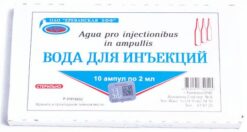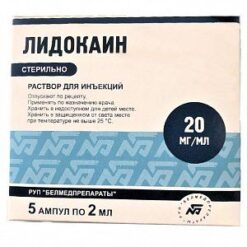No products in the cart.
Leflobakt, 5 mg/ml 100 ml
€12.86 €11.25
EAN: 4602565022402
SKU: 502170
Categories: Anesthesia and resuscitation, Anesthesia solutions, Medicine
Description Pharmacotherapeutic group:
Antimicrobial agent – fluoroquinolone
ATX: Pharmacodynamics: Pharmacokinetics:
Antimicrobial agent – fluoroquinolone
J.01.M.A Fluoroquinolones
J.01.M.A.12 Levofloxacin
Lefloxacin is a synthetic broad spectrum antimicrobial bactericidal drug from the group of fluoroquinolones, containing as active ingredient levofloxacin is the left-handed isomer ofloxacin. Compared with ofloxacin, levofloxacin has a broader spectrum of antibacterial activity, additionally including various streptococci, including pneumococci.
Levofloxacin blocks bacterial DNA-giase (topoisomerase II) and topoisomerase IV, disrupts superspiralization and cross-linking of DNA breaks, inhibits DNA synthesis and causes deep morphological changes in cytoplasm, cell wall and membrane of microorganisms but has no effect on human cell enzymes.
Levofloxacin is active against most strains of microorganisms under both in vitro and in vivo conditions.
In vitro:
Sensitive to levofloxacin (minimum inhibitory concentration (MIC) < 2mg/ml):
Gram-positive aerobic microorganisms: Corynebacterium diphtheriae, Enterococcus faecalis, Enterococcus spp. (except Enterococcus faecium), Listeria monocytogenes, Staphylococcus spp, coagulazonegative (strains sensitive and moderately sensitive to methicillin), Staphylococcus aureus (methicillin-sensitive strains), Staphylococcus epidermidis (methicillin-sensitive strains), Streptococcus spp. group C and G, Streptococcus agalactiae, Streptococcus pneumoniae (sensitive, moderately sensitive and penicillin-resistant), Streptococcus pyogenes, Streptococcus group Viridans (sensitive and penicillin-resistant).
Gram-negative aerobic microorganisms: Acinetobacter baumannii, Acinetobacter calcoaceticus, Acinetobacter spp, Actinobacillus actinomycetemcomitans, Bordetella pertussis, Citrobacter diversus, Citrobacter freundii, Eikenella corrodens, Enterobacter aerogenes, Enterobacter agglomerans, Enterobacter cloacae, Enterobacter spp, Escherichia coli, Gardnerella vaginalis, Haemophilus ducreyi, Haemophilus influenzae (ampicillin sensitive and resistant strains), Haemophilus parainfluenzae, Helicobacter pylori, Klebsiella pneumoniae, Klebsiella oxytoca, Klebsiella spp, Moraxella catarrhalis (beta-lactamase producing and non-producing strains), Morganella morganii, Neisseria gonorrhoeae, Neisseria meningitidis, Pasteurella conis, Pasteurella dagmatis, Pasteurella multocida, Pasteurella spp, Proteus mirabilis, Proteus vulgaris, Providencia rettgeri, Providencia stuartii, Providencia spp., Pseudomonas aeruginosa, Pseudomonas spp., Salmonella spp., Serratia r marcescens, Serratia spp.
Anaerobic microorganisms: Bacteroides fragilis, Bifidobacterium spp., Clostridium perfringens, Fusobacterium spp., Peptostreptococcus spp., Propionibacterium spp, Veilonella spp.
Other microorganisms: Bartonella spp., Chlamydia pneumoniae, Chlamydia psittaci, Chlamydia trachomatis, Legionella pneumophila, Legionella spp, Mycobacterium spp., Mycobacterium leprae, Mycobacterium tuberculosis, Mycoplasma pneumoniae, Mycoplasma hominis, Rickettsia spp., Ureaplasma urealyticum.
Moderately sensitive to levofloxacin (MPC>4mg/l):
Gram-positive aerobic microorganisms: Corynebacterium urealyticum, Corynebacterium xerosis, Enterococcus faecium, Staphylococcus epidermidis (methicillin-resistant strains), Staphylococcus haemolyticus (methicillin-resistant strains).
Gram-negative aerobic microorganisms: Burkholderia cepacia, Campylobacter jejuni/coli.
Anaerobic microorganisms: Bacteroides thetaiotaomicron, Bacteroides vulgatus, Bacteroides ovatus, Prevotella spp., Porphyromonas spp.
Resistant to levofloxacin (MPC >8 mg/mL):
Gram-positive aerobic microorganisms: Corynebacterium jeikeium: Staphylococcus aureus (methicillin-resistant strains), Staphylococcus spp. coagulazonegative (methicillin-resistant strains).
Gram-negative aerobic microorganisms: Alcaligenes xylosoxidans.
Other microorganisms: Mycobacterium avium.
The pharmacokinetics of levofloxacin are linear and predictable with single and multiple drug administration. The plasma profile of levofloxacin concentrations after intravenous administration is similar to that of tablets.
Therefore, the oral and intravenous routes of administration may be considered interchangeable.
The plasma protein binding is 30-40%. It penetrates well into organs and tissues: lungs, mucous membrane of bronchi, sputum, urinary system organs, genitals, bone tissue, cerebrospinal fluid, prostate, polymorphonuclear leukocytes, alveolar macrophages.
The average volume of distribution of levofloxacin is from 89 to 112 liters after single and multiple intravenous administration of 500 mg.
The pharmacokinetic characteristics after single intravenous administration of levofloxacin at a dose of 500 mg, respectively, are: maximum concentration (6.2 ± 1.0) µg/ml, time required to reach maximum concentration – (1.0 7 ± 0.1)h, elimination half-life – (6.4 ± 0.7) h.
Levofloxacin is mainly excreted unchanged by the kidneys.
In case of renal failure the decrease of clearance of the drug and its excretion through the kidneys depends on the degree of decrease of creatinine clearance.
.
Indications
Indications
Infectious inflammatory diseases caused by bacteria sensitive to levofloxacin:
lower respiratory tract (community-acquired pneumonia);
urinary tract and kidney (including acute pyelonephritis);
chronic bacterial prostatitis;
Skin and soft tissue (suppurative atheromas, abscesses, furuncles);
septicemia/bacteremia associated with the above indications;
intra-abdominal infections.
Active ingredient
Active ingredient
Composition
Composition
Composition per 100 ml of the drug:
Active ingredient: Levofloxacin hemihydrate (in terms of Levofloxacin) – 500 mg;
How to take, the dosage
How to take, the dosage
Intravenously drip slowly 1-2 times a day. Doses are determined by the nature and severity of the infection, as well as the sensitivity of the suspected pathogen.
Patients with normal renal function (creatinine clearance >50 ml/min) may be recommended the following dosing regimen:
Out-of-hospital pneumonia: 500 mg of levofloxacin (100 ml of drug) 1-2 times a day, for 7-14 days;
uncomplicated urinary tract infections: 250 mg of levofloxacin (50 ml of the drug) once a day for 3 days;
complicated urinary tract infections (including acute pyelonephritis): 250 mg of levofloxacin (50 ml of the drug) once a day, for 7-10 days;
Skin and soft tissue infections (suppurated atheromas, abscesses, furuncles): 500 mg (100 ml of the drug) 2 times a day, for 7-14 days.
Chronic bacterial prostatitis: 500 mg of levofloxacin (100 ml of drug) once daily, for 28 days;
Septicemia/bacteremia: 500 mg of levofloxacin (100 ml of the drug) 1-2 times daily, for 10-14 days;
intraabdominal infection: 500 mg of levofloxacin (100 ml of drug) once daily, for 7-14 days (in combination with antibacterials acting on anaerobic flora).
Patients with impaired renal function require adjustment of the dosing regimen depending on the creatinine clearance value.
The dosing regimen:
Creatinine clearance
250mg/24h.
500 mg/24 hours.
500 mg/12 hour;
First dose: 250 mg
first dose: 500 mg
first dose: 500 mg
50-20 ml/min.
Thereafter: 125 mg at 125 mg/24 hours.
then:
250 mg/24 hr.
then:
250 mg/12 hr.
19-10 ml/min.
Then at 125 mg/48 hours.
Then: 125 mg/24 hours.
then:
125 mg/12 hr.
Interaction
Interaction
When combined treatment with phenbufen and similar non-steroidal anti-inflammatory drugs, theophylline, the drug may increase the seizure threshold.
Glucocorticoids increase the risk of tendon rupture (especially in the elderly).
Levofloxacin excretion is slightly delayed by cimetidine and probenecid. Levofloxacin causes a slight increase in the blood plasma elimination half-life of cyclosporine.
Concomitant use with warfarin increases prothrombin time and risk of bleeding (close monitoring of INR; prothrombin time and other coagulation indices, as well as monitoring of possible bleeding signs is necessary).
Alcohol may exacerbate central nervous system side effects (dizziness, somnolence).
In diabetic patients receiving oral hypoglycemic agents or insulin hypo- and hyperglycemic states are possible while taking levofloxacin (close monitoring of blood glucose concentration is recommended).
In concomitant use with drugs prolonging the QT interval (antiarrhythmic drugs of classes IA and III, tricyclic and tetracyclic antidepressants, neuroleptics, macrolides, antifungals, imidazole derivatives, some antihistamines, including astemizole, terfenadine, ebastine) QT interval prolongation is possible.
Special Instructions
Special Instructions
In severe pneumonia caused by pneumococci, the therapeutic effect of Leflobact may be insufficient.
After normalization of body temperature, it is recommended to continue treatment for at least 48-72 hours.
The duration of intravenous infusion of 500 mg (100 ml infusion solution) should be at least 60 minutes.
A sensation of palpitation; transient decrease of blood pressure may be observed in individual cases during the infusion. If there is a significant decrease in blood pressure, the infusion should be stopped immediately.
At the time of treatment it is necessary to avoid sunlight and artificial ultraviolet irradiation in order to avoid skin damage (photosensitization).
In case of signs of tendinitis, pseudomembranous colitis and allergic reactions levofloxacin should be stopped immediately.
It should be noted that patients with a history of brain damage (stroke, severe trauma) may have seizures, with insufficiency of glucose-6-phosphate dehydrogenase – risk of hemolysis.
Contraindications
Contraindications
Elderly age, due to the high likelihood of concomitant decreased renal function (glucose-6-phosphate dehydrogenase deficiency).
In patients with brain damage; history (stroke or severe trauma) (possible development of seizures).
In patients with pseudoparalytic myasthenia gravis; with known risk factors for QT interval prolongation.
In patients with diabetes mellitus.
The use of levofloxacin concomitantly with other QT interval prolonging agents is not recommended because the risk of cardiac arrhythmias increases.
Predisposition to seizure reactions (cerebral atherosclerosis, cerebral circulatory disorders (in anamnesis), organic diseases of the central nervous system), renal failure, congenital prolongation of the QT interval syndrome, heart disease (heart failure, myocardial infarction, bradycardia), electrolyte imbalance (e.g. in hypokalemia, hypomagnesemia), psychosis and other mental disorders in the history, hepatic porphyria/ concurrent use of drugs that prolong the QT interval, (antiarrhythmic drugs of classes IA and III, tricyclic and tetracyclic antidepressants, neuroleptics, macrolides, antifungals, imidazole derivatives, some antihistamines, including astemizole, terfenadine, ebastine) and lowering the threshold, seizure readiness of the brain (phenbufen, theophylline).
Side effects
Side effects
Digestive system disorders: nausea, vomiting, diarrhea, decreased appetite, abdominal pain, pseudomembranous colitis; increased liver transaminase activity, hyperbilirubinemia, hepatitis, dysbacteriosis, severe liver failure, including cases of acute liver failure, especially in patients with severe underlying disease (eg, sepsis).
Cardiovascular system disorders: decreased blood pressure, vascular collapse, tachycardia, prolonged QT interval.
Metabolic disorders: hypoglycemia (increased appetite, increased sweating, shivering), porphyria attacks.
Nervous system disorders, headache, dizziness, weakness, drowsiness, insomnia, paresthesias, peripheral sensory and sensorimotor neuropathy, anxiety, fear, psychotic reactions, self-harming behavior, including suicidal thoughts and actions, hallucinations, confusion, depression, movement disorders, seizures, tremor, extrapyramidal disorders, agitation (agitation), nightmares.
Sense organs: agueusia, dysgeusia (perversion of taste), loss of taste sensation, parosmia (disorder of sense of smell, especially subjective sense of smell, objectively absent), including loss of smell, vertigo (feeling of deviation or twisting or own body or surrounding objects), ringing in ears, hearing loss.
Musculoskeletal system: arthralgia, myasthenia, myalgia, tendon rupture, tendinitis, rhabdomyolysis.
Urinary system disorders: hypercreatininemia, interstitial nephritis, acute renal failure.
Hematopoietic disorders: eosinophilia, hemolytic anemia, leukopenia, neutropenia; agranulocytosis, thrombocytopenia, pancytopenia, hemorrhages.
Allergic reactions: itching, hyperemia, swelling of the skin and mucous membranes, urticaria, erythema malignant exudative (Stevens-Johnson syndrome), toxic epidermal necrolysis, bronchospasm, choking, shortness of breath, anaphylactic shock, allergic pneumonitis, vasculitis.
Local reactions: phlebitis and periphlebitis.
Others: exacerbation of porphyria, photosensitization, persistent fever, development of superinfection, asthenia.
Overdose
Overdose
Pregnancy use
Pregnancy use
Similarities
Similarities
Additional information
| Shelf life | 2 years. Do not use after the expiration date printed on the package. |
|---|---|
| Conditions of storage | In a place protected from light at a temperature of 15 to 25 ° C. The infusion solution can be stored without light protection for no more than 3 days. Freezing is not allowed. Store in places out of the reach of children. |
| Manufacturer | Sintez OAO, Russia |
| Medication form | solution for infusion |
| Brand | Sintez OAO |
Related products
Buy Leflobakt, 5 mg/ml 100 ml with delivery to USA, UK, Europe and over 120 other countries.



